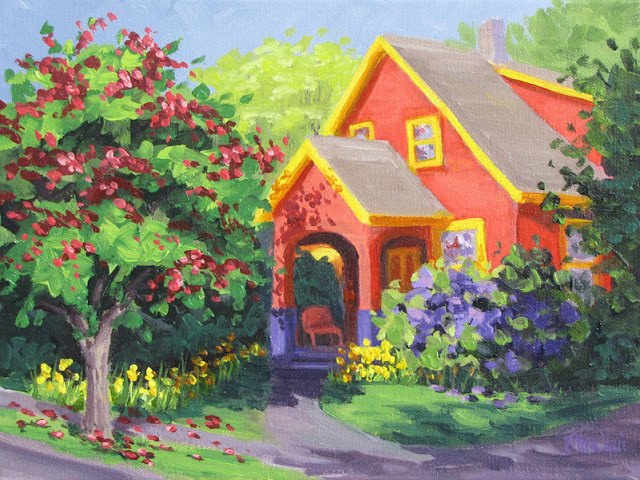I've been slacking off pretty hard in the last year or so. I'm working much less at the "Day Job" with the plan being to do a lot more painting, blogging, and video making! Ha! Best laid plans and all that. I've spent much more time sleeping in and staring out the window!
But with the spring comes new resolve :) The plan is to create a new full length video course each month, a "Small Talk" short video each week, and a "Studio Update" a couple of times a week. I've even got a weekly calendar complete with color coding!
I'm feeling optimistic and energized these days. I don't know about you, but whenever I'm pumped up about a new plan I tend to wake up at 2 or 3 in the morning and my mind is racing with all the exciting possibilities! Some of which lose a lot of their shine in the cold light of day, but they do succeed in robbing me of sleep :) It's worth it though, to feel in the "flow" with ideas streaming through me. I love it!
So, I hope you will hold me to my new plan, don't give me any slack!
This week in the Studio:
Personal Painting - I've been working on a series of paintings of colorful houses in my neighborhood - you can see some of them in my
"Next Door Beauty" Post
The series is all color. So I'm working on simplifying my shapes, editing out detail, keeping my brushstrokes loose. It doesn't come easily for me! I'm always finding myself getting lost in the reference and rendering all the details.
One solution I've been working with is to take my reference photo into PhotoShop and manipulate the image there before I start to paint. Getting rid of detail, adjusting color, moving things around.
So here is how that works:
This is the reference for my current painting:
This looks like a house in the country, right? Actually this is in my neighborhood in Portland, Oregon! Families are allowed to keep chickens in their yards in the city limits (no roosters, thankfully!) Growing produce in raised beds is also very common. I love it!
I especially love the vivid blue on the house. There is actually an old pickup truck that lives here too that is almost the same color as the house! I thought about adding it to the photo, but decided it would be too much going on.
So, after PhotoShopping - I came up with this
I'm still on the fence about some things. I couldn't decide between yellow and red-orange for the accent colors and ended up with both. Hmmm. Still not sure if it's too much.
I love bringing all the flowers into bloom. Sometimes a house just seems to be begging me to give it a makeover :)
I got rid of the fences and added a stepping stone path to make things more inviting
The final thing I'm not sure about is the way the corn and the chairs on the porch kind of make that area too busy. Especially since for it to really read "corn" I would probably have to make it taller and add some tassels - which would cover up the chairs entirely.
but I love having seating on the porch! Just makes me want to grab a beverage and relax there! I'm thinking about changing the corn to tomatoes. I can keep them lower and I'd have that nice pop of red there, too. Hmmmm.
I'll probably add one more chicken as well. It just seems nicer to have three. Did you notice I had to add a head to the one on the right? Haha, it was turning or some such thing and doesn't have a head in the photo.
Overall I can't decide if I want to dial back on the number of colors in general. It's pretty much a rainbow now!
So far I've just done the block in. I like to block in with regular acrylics, then come back with Open Acrylics for the final layer. They dry slowly and give me more time to blend....
What I focus on at this stage is getting my values right. I think I'm pretty happy there. I've shifted the blue toward the red a bit though and I don't think that is working for me. This is the time to change things like that! Stay tuned for the update!
What is on My Calendar for today though is working on a new full length Video Course for
My Online School
I think I'll be painting a version of this painting - and talking a lot about shadows and dappled light... I just did a
blog about it - focusing on the use of greens and painting park settings
Learning to paint shadows successfully is so rewarding! Ha, I'm inspiring myself here! Off I go to work on it! :)




























